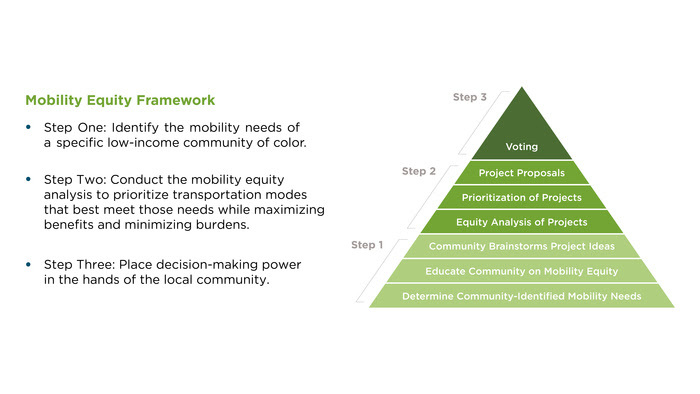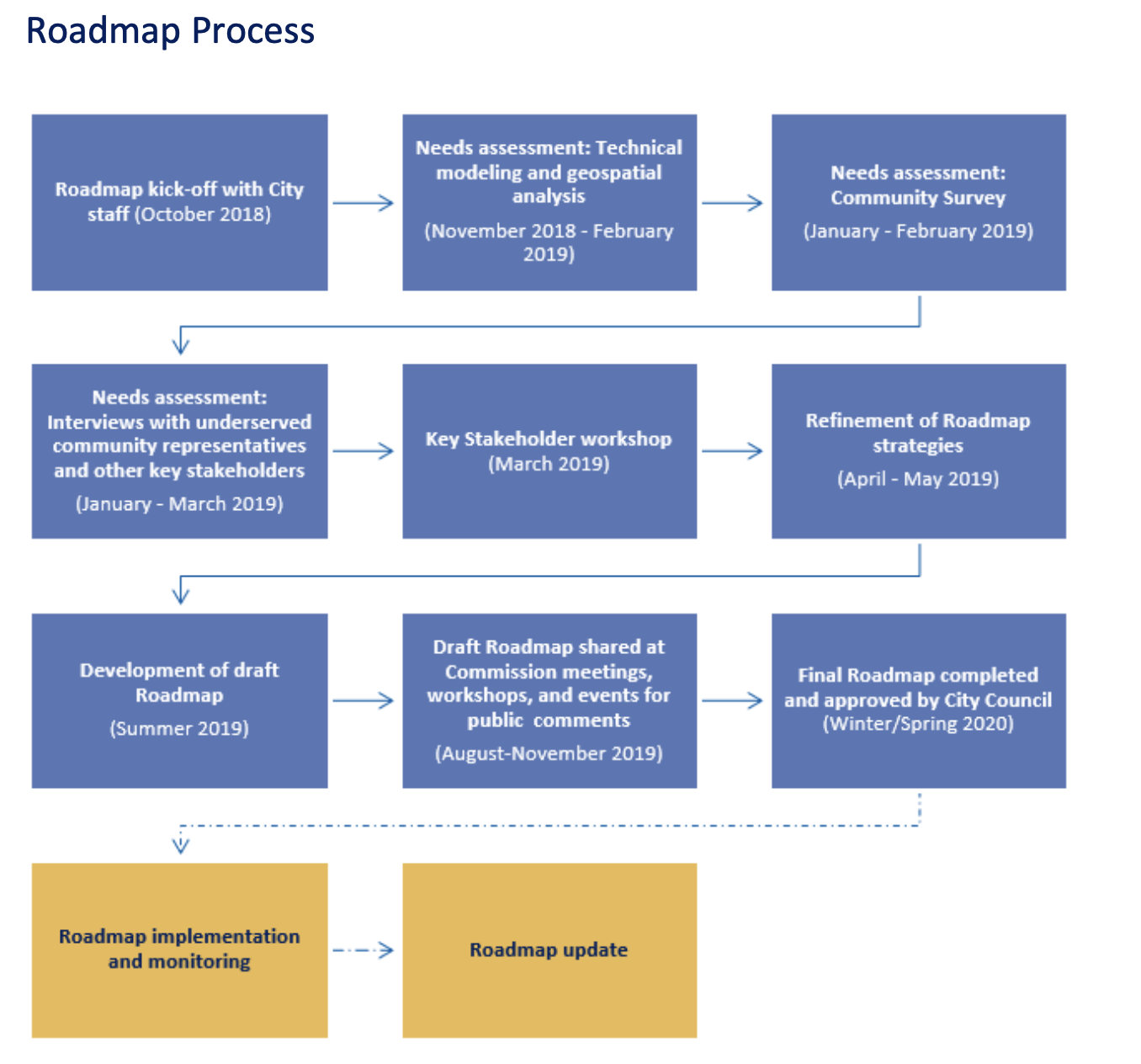Fixing Our Broken Transportation System Requires This Kind of Community Leadership

Our transportation system today is falling apart at the seams. Gas prices are sky-rocketing at an alarming rate while traffic and congestion has roared back with a fury after the COVID-19 lockdowns and people returning to school and work. Cash-strapped public transit agencies are still reeling from a loss of pandemic ridership and are struggling to provide frequent and reliable service to riders. Pedestrians and bicyclists are suffering from record collisions and fatalities by vehicles. People are forced to choose between bad and worse mobility options. This lack of affordable, reliable, and safe choices harms low-income communities’ pocketbooks and livelihoods most. So who can we blame for a transportation system that is failing us on so many levels?
Well, let’s start at the beginning with the long legacy of top-down transportation planning and decision-making processes largely led by people who don’t represent the diverse array of folks they make decisions for. We can blame decades of decision-makers who have prioritized expanding highways at the expense of underfunding walking, biking, and public transit investments. These decisions are directly responsible for low-income communities of color disproportionately suffering from transportation-related air pollution, traffic fatalities, and longer, less reliable commutes. Not to mention that our fossil-fuel addicted transportation sector is the largest contributor to climate change. Our current model is failing to meet the needs of communities of color, while causing real harm. There has never been a more crucial time to reimagine how our transportation planning and decision making process could be more equitable and sustainable.
While I could point fingers all day at why we’re in this mess — in the spirit of Earth Month, I’m going to uplift some hopeful examples of programs and big ideas that are working.


The Mobility Equity Framework
But first let’s rewind a few years. In 2018, The Greenlining Institute published the Mobility Equity Framework, a tool outlining how to center a bottom-up, community-led approach in transportation planning and decision-making with the goal of avoiding many of the harmful mistakes of the past. The framework includes step-by-step guidance to center community needs and decision-making power in transportation planning for planners and community advocates. By utilizing this Framework, the goal is for communities to identify how to prioritize an array of clean mobility options in order to best meet their needs. These are the three steps, with substeps within each.
By design, the Framework is intended to be flexible, adaptable, and easy to use. We encourage folks to pick it apart, alter and build onto it so it better meets their needs.
In the four years that The Greenlining Institute’s Mobility Equity Framework has been published, it has been utilized by a variety of state and local government, transit agencies, and advocates to uplift community needs and voices in the transportation planning and decision making process.
Here are a few case studies of communities that have utilized the Framework to enact clean mobility options that actually meet community-needs:

District 10 in San Francisco
In 2019, The San Francisco County Transportation Authority brought in the Reflex Design Collective to understand and address the transportation justice issues in District 10 of the city. This demographically diverse district has a long, rich history of organizing and activism. This is necessary in a community that faces a legacy of redlining, disinvestment, environmental injustice, gentrification, and displacement. Reflex utilized Greenlining’s definition of mobility equity and followed the 3 Steps of the framework, and they documented their thoughtful process in this blog.
First Reflex developed a process for the community to identify their most pressing mobility needs. Rather than just develop a standard survey, the team partnered with community leaders and intentionally created an accessible, and culturally relevant space for dialogue. The result of these Equity Design workshops were 150+ residents who were paid to brainstorm and co-design over 90 ideas to make transportation more equitable in their community. Next, these 90 project ideas were put through an equity analysis that was designed to reflect the values and needs of District 10, in addition to equity, feasibility, and financial sustainability. A final workshop was held, where residents worked with city staff to adapt the final proposals and decided to implement 10 clean mobility options, such as a community shuttle to the grocery store and a subsidized carpool service to bring children to school. All 10 of the proposals were unanimously approved by the SF Board of Supervisors and the city has begun to implement the projects.
Clean Mobility Options Voucher Pilot Program
Clean Mobility Options is a California statewide program that provides funding for needs assessment and the implementation of mobility projects including a wide array of zero-emission car share, carpool, vanpool, bike share, scooter-share, innovative transit services and ride-on-demand services. These funds are explicitly targeted to disadvantaged communities, with and there is a 10% set aside in funding for Tribal applicants. Clean Mobility Options requires applicants to demonstrate that the proposed projects are community-driven and based on direct engagement with the community.
The inclusion of a mobility needs assessment was based off of the process outlined in Greenlining’s Mobility Equity Framework. This was a big step forward for the California Air Resources Board (CARB) who runs the program. Despite funding clean vehicle incentives and car sharing programs for years, CARB had operated these investments with a top-down, prescriptive approach that did not meet a wider array of peoples’ mobility needs — particularly those who did not drive. By first asking, “What are the most pressing unmet mobility needs of particular underserved communities?” planners can reveal how well a proposed project or investment will address community needs, whether the benefits are significant, whether the benefits target low-income residents, and whether the proposal avoids harms to the community. Genuinely identifying community mobility needs must always be the first step in the transportation planning process in order to guarantee that the proposed projects will provide benefits and reduce harms.
Berkeley’s Electric Mobility Roadmap
The City of Berkeley published their Electric Mobility Roadmap in 2020, which outlines how the city will equitably reach a fossil-free transportation system that integrates and supports the City’s ongoing efforts to increase walking, biking, and public transit usage. Greenlining’s Framework informed the overarching goals and strategies of the City’s Roadmap, centering an equity lens through which all proposed strategies were filtered.
First, Berkeley followed Step 1 of the Framework by beginning the development process with community needs assessment through surveys, then interviews with communities and key stakeholders, and finally in key stakeholder workshops.

Next, Berkeley evaluated roadmap strategies and refined proposals into a draft. This draft was then shared at community meetings and workshops, and then the final plan was ultimately approved by the City Council.
Congestion Pricing in San Francisco
The San Francisco County Transportation Authority (SFCTA) began researching congestion pricing to charge drivers a fee to drive into the most heavily trafficked areas during rush hours, with the goal of reducing the number of cars on the roads and to use funds generated to invest in safer streets and improving public transit. In other cities where congestion pricing has been implemented, everyone pays the same price regardless of income. San Francisco wanted to take a more equitable approach to ensure that underserved communities are not disproportionately burdened by the fees and benefit most from how the revenue is invested.
Using our Mobility Equity Framework as a guide, SFCTA conducted a listening phase to inform their community engagement strategy, paid community-based organization to co-host workshops, compensated community members at co-design workshops, and ensured centered community engagement in the decision-making process. This community co-design process guided SFCTA to outline various proposals to build equity into the fee structure, and helped inform how revenues are distributed. Greenlining published a series of blogs detailing SFCTA’s process, first outlining the equity strategy and, second identifying best practices.

Pricing Options in Portland
In 2020, the Portland Bureau of Transportation and Bureau of Planning and Sustainability assembled a Community Task Force to investigate Pricing Options for Equitable Mobility Project, or POEM. According to their website, the POEM project started with a question: Should we use pricing strategies more intentionally in Portland to create a more equitable and sustainable transportation system?
These pricing strategies could apply to parking, delivery services, highway use, or road use. And the project sought to investigate if pricing strategies could improve mobility, address the climate crisis, and make the transportation system more equitable. To prioritize the needs of BIPOC communities, The POEM Community Task Force utilized the Greenlining Framework to develop their own Equitable Mobility Framework to inform policy and decision-making. The Community Task Force voted to move its recommendations forward to City leadership in July 2021, and in October 2021, the City Council accepted the POEM Task Force’s final report and directed city staff to begin developing fee and investment proposals in line with the Task Force’s recommendations.
Oakland’s Equitable Climate Action Plan
The City of Oakland’s Equitable Climate Action Plan (ECAP) serves as a roadmap for an equitable transition to a low-carbon economy by 2030.
Oakland’s ECAP calls for the use of the three steps of the Framework to implement policies and programs related to new mobility, to ensure that they are equitably responding to community needs and characteristics. The ECAP also notes the importance of utilizing the Framework to amplify community voices, avoid unintended consequences, and rectify historical racial disparities as projects are developed and implemented.
King County Metro Mobility Framework
In October 2019, Washington State’s King County Metro developed a Mobility Framework to guide the agency’s transportation system to be more equitable and environmentally sustainable. The framework was co-created with the Equity Cabinet, composed of 23 leaders representing diverse communities across the region focused on low- and no-income BIPOC, immigrant, refugee, people with disabilities, and limited English speaking communities. The Equity Cabinet established ten Guiding Principles for the Mobility Framework to ensure the region’s emerging mobility systems are “innovative, integrated, equitable, and sustainable.” These guiding principles were informed and adapted from Greenlining’s Framework, which was also included as a best practice for the future implementation of projects.
A Transit Campaign Advocacy Tool in Durham, North Carolina
The Transit Equity Campaign in Durham, North Carolina is calling for improvements in accessibility, frequency, reliability, and safety to promote anti-racism and equitable outcomes for Durham County Transit users, who are predominantly low-income and BIPOC communities. The campaign organizers state that in order to secure these equitable outcomes, the needs of underserved communities must be prioritized and centered in the planning and decision-making process. They recommend that the Durham County Transit Plan utilize Greenlining’s Mobility Equity Framework to guide this process. Campaign staff noted that Greenlining Framework has served as a helpful tool to communicate a new way of planning projects to our public sector staff in Durham.
When planners and policymakers prioritize equity, the result is mobility projects and policies that more accurately and equitably meet the needs of underserved communities. At a time when our transportation system is falling apart and mobility options aren’t meeting anyone’s needs, there has never been a more appropriate time to rebuild our transportation system from the bottom up.



